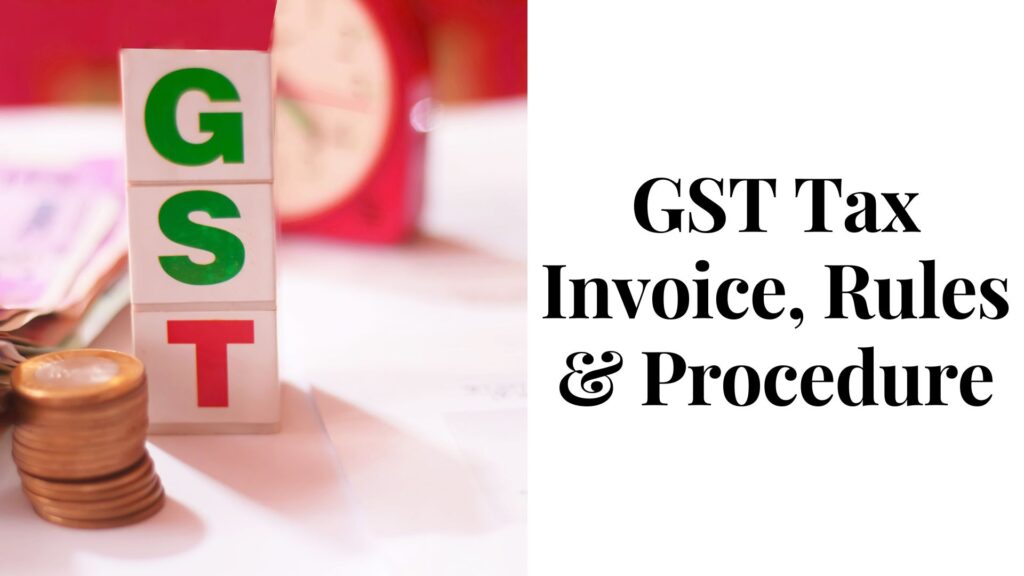A registered taxpayer who supplies goods or services to another registered taxpayer will issue them with a GST tax invoice. The tax invoice contains details such as the GST registration number of the supplier, details of the goods or services supplied, the value of the goods or services, the GST rate, and the amount of GST charged.
Here are the rules and procedures related to GST tax invoice:
Time of issue: The supplier must issue a tax invoice within 30 days from the date of supply of goods or services.
Content of the tax invoice: A tax invoice must contain the following details:
a) Name, address and GSTIN of the supplier
b) A string of consecutive numbers with a maximum character length of 16
c) Date of issue
d) Name, address and GSTIN of the recipient
e) HSN/SAC code of goods or services supplied
f) Description of goods or services supplied
g) Quantity and unit of measurement
h) Total value of supply of goods or services
i) Taxable value of supply
j) Rate of GST (CGST, SGST/UTGST, IGST)
- k) Amount of GST charged
Issuing tax invoice for exports: For exports, the supplier must issue a tax invoice with the following additional details:
a) The name and address of the recipient
b) “Supply is meant for export on payment of IGST”
- c) The name of the country of destination
- Issuing tax invoice for reverse charge: When the recipient is liable to pay tax under reverse charge, the recipient must issue a tax invoice on behalf of the supplier. The recipient must mention that the tax is payable on a reverse charge basis on the tax invoice.
- Maintenance of tax invoice: The supplier must maintain a copy of the tax invoice issued for a period of 6 years from the date of the invoice.
- Cancellation of a tax invoice: Once a tax invoice has been issued, it cannot be cancelled. However, a credit note or debit note may be provided to make up for errors or omissions in the tax invoice.
A proper understanding of these rules and procedures can help taxpayers avoid any compliance-related issues.
Regenerate response
Types of GST Invoice
Various GST invoice types include:
- Tax Invoice: This is the most common type of GST invoice that is issued for the supply of goods or services in the course of business. It contains details such as the name and address of the supplier, name and address of the recipient, description and quantity of goods or services supplied. GST rate, and the amount of GST charged.
- Bill of Supply: A bill of supply is issued in cases where GST is not applicable or where the supplier is not registered under GST. And sales of goods or services that are outside the purview of GST.
- A revised invoice is sent out to correct any mistakes or omissions in the initial tax invoice. It can be used to fix mistakes such an inaccurate GST rate, HSN code, or invoice number.
In conclusion, understanding the different types of GST invoices is important for businesses to ensure compliance with GST laws and regulations. Depending on the nature of the transaction, businesses need to issue the appropriate type of GST invoice to avoid any compliance-related issues.
What are GST Invoice Rules
The GST invoice rules govern the issuance of tax invoices by registered taxpayers for the supply of goods or services. Here are the key GST invoice rules:
Content of the tax invoice: A tax invoice must contain the following details:
a) Name, address and GSTIN of the supplier
b) A string of consecutive numbers with a maximum character length of 16
c) Date of issue
d) Name, address and GSTIN of the recipient
e) HSN/SAC code of goods or services supplied
f) Description of goods or services supplied
g) Quantity and unit of measurement
h) Total cost of the products or services supplied
i) Taxable value of supply
j) Rate of GST (CGST, SGST/UTGST, IGST)
- k) Amount of GST charged
Tax invoice for exports: Along with the information already provided. The tax invoice for exports must also include the following information:
a) The name and address of the recipient
- b) The name of the country of destination
- Issuing invoice for reverse charge: When the recipient is liable to pay tax under reverse charge. The recipient must issue a tax invoice on behalf of the supplier. The recipient must mention that the tax is payable on a reverse charge basis on the invoice.
- Electronic invoices must, however, be verified using a digital signature or another electronic technique.
- Maintenance of invoice: The supplier must maintain a copy of the tax invoice issued for a period of 6 years from the date of the invoice.
It is important for businesses to comply with these rules to avoid any compliance-related issues.
Suggested Read: GST Filing

